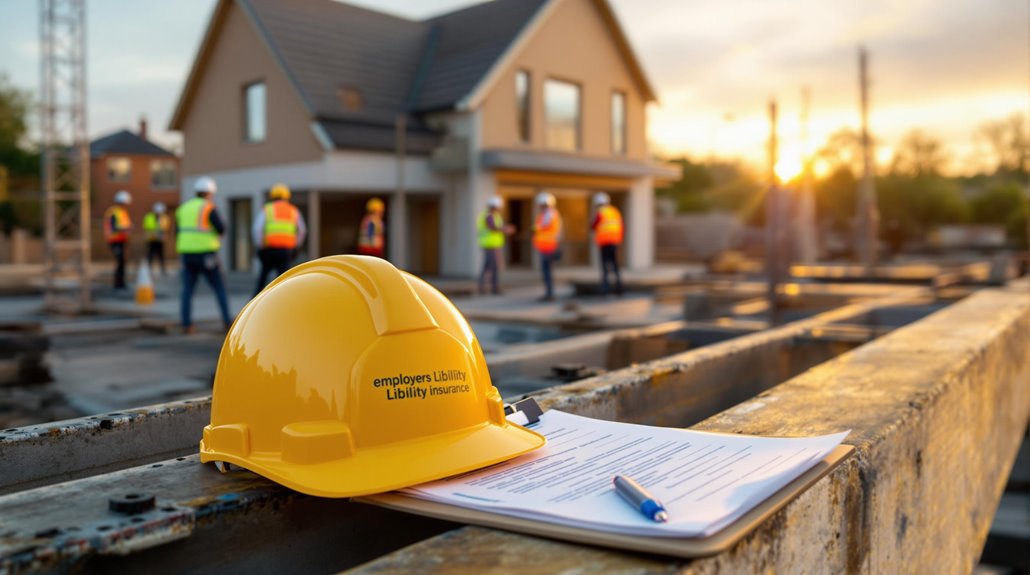I’ve seen too many UK homeowners discover the hard way that their builder’s insurance doesn’t cover what they thought it would. When your contractor’s public liability policy has gaps or their employers’ liability coverage isn’t sufficient, you’re left holding the financial bag for accidents, injuries, and property damage. The legal obligations alone can expose you to £2,500 daily fines, but that’s just the beginning of what could go wrong with your project.
Key Takeaways
- Verify builders have minimum £2 million public liability insurance to protect against third-party injury claims and property damage.
- Ensure builders carry employers’ liability insurance with £5 million minimum coverage to avoid daily £2,500 fines for non-compliance.
- Secure contract works insurance covering £10,000-£1.5 million to protect unfinished projects from theft, vandalism, and weather damage.
- Standard home insurance excludes construction risks, requiring dedicated renovation insurance with public liability and material protection extensions.
- Obtain written contracts specifying insurance responsibilities and maintain digital copies of all certificates with policy numbers and dates.
Understanding Your Legal Obligations When Hiring UK Builders

When hiring builders in the UK, you’re stepping into a regulatory landscape that’s more complex than most homeowners realize. You might assume builders operate under mandatory licensing—45% of homeowners do—but there’s actually no statutory licensing system. This means you’ll need to verify credentials yourself through organizations like the Federation of Master Builders.
Here’s what you’re legally responsible for: ensuring all work complies with building regulations, regardless of who does it. Non-compliance can trigger enforcement notices, fines, and insurance voids. You must secure proper approvals for structural changes, rewiring, and bathroom installations. Engaging a new build solicitor can help you navigate these complexities effectively.
Before hiring anyone, I recommend confirming they carry minimum £2 million public liability insurance and obtaining written contracts specifying regulatory responsibilities. As a building owner, you must also ensure your property meets safety standards and rectify any historical safety defects that may exist. These steps protect you from costly mistakes.
Public Liability Insurance: Your First Line of Defense Against Third-Party Claims
Although you’ve secured the right builder with proper credentials, your financial protection hinges on understanding public liability insurance—the critical barrier between construction incidents and personal bankruptcy. This coverage protects you when third parties suffer bodily injury or property damage during construction activities on your property.
With UK liability payouts totaling £13 billion in 2020—a staggering 31% annual increase—you’re facing real financial exposure. Every day brings £7.6 million in liability claims across the country. Your builder’s public liability insurance becomes your shield when neighbors’ property gets damaged, visitors get injured, or faulty workmanship causes downstream problems. To further protect your investment, it’s essential to consider the average costs associated with these legal safeguards.
I recommend verifying your builder carries minimum £2 million coverage. This isn’t paranoia—it’s smart homeownership. The average cost of public liability cover is £118 per year, making it an affordable safeguard against potentially catastrophic financial exposure. Without proper coverage, you’re personally liable for incidents that could devastate your finances permanently.
Employers’ Liability Insurance: The Mandatory Coverage That Could Save You £2,500 Daily Fines

While public liability insurance protects against third-party claims, employers’ liability insurance addresses a different but equally critical exposure—your legal obligation to workers on your construction project.
Here’s what you need to know: if you’re employing anyone—from full-time builders to casual laborers, temps, or even volunteers—you’re legally required to carry employers’ liability insurance under the Employers’ Liability (Compulsory Insurance) Act 1969. There’s no grace period; coverage must begin immediately upon becoming an employer.
The minimum coverage is £5 million, though most policies offer £10 million. Skip this requirement, and you’ll face £2,500 in daily fines, plus an additional £1,000 for failing to display your certificate. You must also register with HMRC to fulfill your tax and national insurance obligations as an employer.
Limited exemptions exist for family members in non-limited company structures, but verification is essential.
Contract Works Insurance: Protecting Your Unfinished Project From Vandalism and Weather Damage
Since your construction project represents months of investment in materials and labour, contract works insurance becomes essential protection against the unique vulnerabilities of unfinished buildings. I’ll show you how this coverage safeguards your project from vandalism, theft, fire, floods, and storm damage—the risks that typically devastate exposed construction sites. Additionally, securing a professional evaluation of your construction quality can help identify potential issues early on, ensuring your project remains on track.
You’ll get extensive protection for all new construction elements, unused materials stored on-site, and even equipment in transit. Coverage operates on an “all risks” basis, providing the broadest protection available with limits from £10,000 to £1.5 million. This specialized coverage aids in restoring the project to its previous status after damage, ensuring your construction timeline can continue with minimal disruption.
Professional Indemnity Insurance: Safeguarding Against Design Flaws and Technical Negligence

Contract works insurance protects your physical construction from external threats, but professional indemnity insurance (PII) shields you from internal risks—the design errors, technical miscalculations, and professional oversights that can trigger devastating financial liability.
I’ll be direct: design flaws constitute the core exposure driving PII claims in construction. When your architect miscalculates load-bearing requirements or your engineer overlooks ventilation adequacy, you’re facing potential legal action that could exceed your project’s entire value. It’s essential to recognize that landlord insurance can provide insight into the importance of safeguarding your financial interests against unexpected liabilities.
Professional indemnity claims represent 26% of all UK business insurance claims—they’re devastatingly common. With construction PII premiums reaching £600 million annually, insurers recognize these risks are real and expensive. The UK professional indemnity market now covers over 500 occupation types, reflecting the widespread nature of professional liability risks across industries.
Don’t assume your contractor’s existing coverage protects you adequately. Verify their PII limits match your project’s exposure, because technical negligence claims can destroy both your build and your financial security.
Verification Process: How to Check Your Builder’s Insurance Certificates Before Work Begins
How can you avoid the catastrophic scenario where your builder’s insurance lapses mid-project, leaving you exposed to unlimited liability? I’ll show you the exact verification steps that separate savvy homeowners from those who learn expensive lessons.
First, contact the insurer directly using details on the certificate—don’t rely on what your builder tells you. Verify the policy’s active and coverage dates align with your project timeline. Check policy limits meet your needs (I recommend £1m+ public liability minimum). A comprehensive builder’s insurance policy can help mitigate unique risks associated with rental properties.
Confirm additional insured endorsements if your contract requires them. Review exclusions carefully in the certificate’s notes section. Given the current decline in construction contract awards, it’s more important than ever to ensure your builder maintains proper financial backing and insurance coverage.
For subcontractors, verify their registration through HMRC’s CIS portal using their UTR or National Insurance number. This simple step protects you from construction industry tax complications.
Shared Liability Risks: Why Inadequate Builder Insurance Makes You a Target for Lawsuits
When your builder’s insurance proves inadequate, you become the primary target for expensive lawsuits—and UK liability claims cost businesses £7.6 million daily, with homeowners bearing the brunt when coverage gaps emerge.
I’ve seen homeowners face bankruptcy from third-party claims when their builder’s £1M policy couldn’t cover a £3M lawsuit. You’re legally liable for contractor actions on your property, regardless of fault. When visitors slip on construction debris or neighboring properties suffer damage from falling materials, lawyers target you as the deep-pocket defendant. Furthermore, understanding typical costs involved in builder insurance can help you avoid potential pitfalls and ensure you’re adequately covered.
Rising construction costs make standard policies insufficient, while underinsured builders shift liability risks directly to you. Your personal assets—including your home and savings—become vulnerable when judgments exceed your builder’s policy limits. With construction rates decreasing significantly and ample capacity available, securing proper coverage has never been more affordable or accessible. Don’t let inadequate coverage destroy your financial future.
Homeowner Insurance Extensions: Securing Additional Coverage When Builder Policies Fall Short
Although standard home insurance appears thorough, it systematically excludes the very risks you’ll face during construction projects—leaving dangerous coverage gaps that can cost tens of thousands when accidents occur.
I’ve seen homeowners discover too late that their standard policies won’t cover extension damage, Party Wall liabilities, or neighbour property incidents. You’ll need dedicated renovation insurance that explicitly covers existing structures, new builds, and materials simultaneously. Ensuring you have the right coverage in place is essential to avoid service interruptions that can arise from unforeseen events.
Essential extensions include public liability for non-negligence accidents, alternative accommodation if your property becomes uninhabitable, and protection for materials before installation. Hiscox offers coverage up to £250,000, but projects exceeding £75,000 require extensive add-ons. Most building projects exceed their original budget and schedule, creating additional exposure that requires careful coverage planning.
Don’t rely solely on builder coverage—their policies only address their negligence, not the broader risks you’re actually exposed to during construction.
Long-Term Protection Strategies: Building Work Guarantees and Extended Coverage Options

While your immediate construction coverage protects against accidents and delays, securing your investment requires extending protection well beyond project completion through extensive warranty and latent defects insurance. I recommend securing policies spanning 10-12 years with full reinstatement coverage that includes built-in annual inflation indexation of 5%.
You’ll benefit from extending standard 2-year builder warranties to 12 years, covering structural defects plus mechanical and electrical systems. These policies activate after your builder warranty expires, addressing latent defects that emerge years later. With coverage limits exceeding £25 million and no claim excesses, you’re protected against catastrophic losses.
The reinstatement coverage accounts for current construction costs without depreciation, covering demolition, debris removal, and professional fees—ensuring complete restoration of your property investment. Working with experienced underwriters ensures fast and flexible service when customizing your long-term protection strategy to match your specific project requirements and risk profile.
Documentation and Legal Safeguards: Essential Steps to Minimize Your Financial Exposure
Before any construction work begins, you must establish a thorough documentation system that serves as your primary defense against financial catastrophe. I’ll guide you through the essential safeguards that protect your investment.
First, request and retain digital copies of your builder’s insurance certificates, ensuring they cover your specific project scope and duration. You’ll need public liability, employers’ liability (mandatory with staff), and contract works insurance as minimum requirements. Verify policy limits meet industry standards and check renewal dates for continuous coverage. Understanding the difference between building insurance and home insurance is crucial for adequate protection.
Document everything systematically – store certificates digitally with backups, log all correspondence, and record policy numbers with underwriter details. Secure signed contracts specifying insurance obligations and penalties for non-compliance. Track expiry dates religiously and obtain proof of trade association memberships requiring insurance compliance. Consider insurance-backed guarantees that provide financial protection even if your builder ceases trading during or after your project completion.
Conclusion
I’ve outlined the critical insurance requirements that’ll protect your UK building project from devastating financial risks. You can’t afford to overlook public liability, employers’ liability, or contract works coverage—each serves as essential protection against different threats. Don’t rely solely on your builder’s policies; verify coverage gaps and secure additional protection where needed. Take action now by reviewing your current coverage and implementing these safeguards before starting construction.
References
- https://www.renovationplan.co.uk/news-and-insight/what-insurance-do-i-need-for-building-work/
- https://resi.co.uk/advice/construction-advice/guide-to-insurance-construction
- https://www.fmb.org.uk/resource/what-insurance-do-you-need-for-home-improvement-work.html
- https://www.comparethemarket.com/home-insurance/content/what-insurance-should-a-builder-have/
- https://www.nerdwallet.com/uk/business-insurance/builders/
- https://www.gov.uk/guidance/what-are-my-building-owners-legal-obligations
- https://www.fmb.org.uk/resource/almost-half-of-homeowners-wrongly-believe-builders-are-licensed.html
- https://www.citizensadvice.org.uk/consumer/getting-home-improvements-done/before-you-get-building-work-done/
- https://www.fmb.org.uk/find-a-builder/ultimate-guides-to-home-renovation/building-regulations-what-you-need-to-know.html
- https://witansolicitors.co.uk/building-liability-orders/

